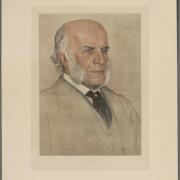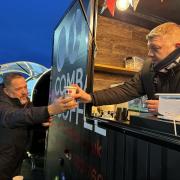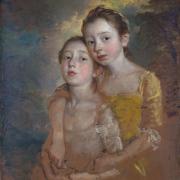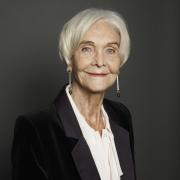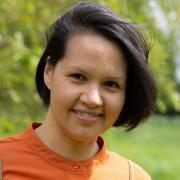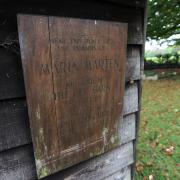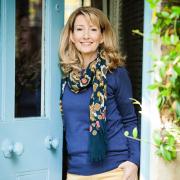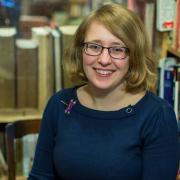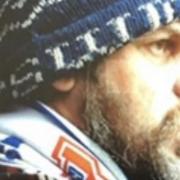Most families battling over a game of Cluedo would be delighted to solve the mystery with ‘Professor Plum in the library with a candlestick!’
But when your mother is a celebrated expert on BBC’s Antiques Roadshow, author of around 100 books on antiques and collectables, and the owner of a publishing company producing The Miller’s Antique Price Guide, it's never going to be that simple. What type of candlestick? What is it made of? How old is it? Is it a valuable antique?
But it was just such a conversation with her famous mum, Judith, that set Cara Miller on the trail of her first novel, The Antique Hunter’s Guide to Murder, set in Suffolk and expected to be a popular series of murder mysteries in the world of antiques.

One of six children, Cara was always a keen reader – ‘The kid in the corner with a book while chaos reigned around us’ – and those early years of living and playing among valued objects never left her.
Home was a dilapidated pile of a house, in the midst of renovation, packed with old furniture, ceramics and jewellery, with candlesticks often close at hand because the electricity was off.
Now in her forties with her own family, Cara has been writing for ever and tried to get published about nine years ago. ‘I started with children’s books, because I had children,' she says, 'but I’ve always read crime. I just never felt I had a good enough story of my own.’

Then talking to her mum in lockdown set Cara thinking. ‘I mentioned our family games of Cluedo and we started talking about the candlestick being brass or silver, Art Deco or Georgian. And then I wondered, what if the antique wasn’t the murder weapon but the reason for the crime. So I asked my mum what antique she would kill for.’
Judith, who sadly died fairly recently, was a warm, gracious and generous woman, but nevertheless rose to Cara’s challenge and nominated the extraordinary Martin Brothers Bird as the antique she thought would prove most coveted and likely to engender violence. With this final piece in the puzzle Cara was off, writing the first draft of her novel in just three months.
The Antique Hunter’s Guide to Murder (Macmillan) sees Freya and her Aunt Carole investigating the suspicious death of their friend and mentor, an antiques dealer in a Suffolk village. There are letters and diaries to decipher, antiques weekends to attend, fakes and frauds to uncover... and the lure of the Martin Brothers Bird.

‘I talked through all the antiques in the book with my mum,’ says Cara. ‘Her knowledge was incredible. I could ask her anything.’
The detective duo are two feisty females; one in her 40s at the crossroads of her life, the other in her 70s still seeking adventure. ‘I didn’t want Miss Marple knitting in the corner,’ Cara says. ‘Even in her 70s, Carole has still got huge energy for life.’
And the setting for the book was inspired by Cara’s recent move to Suffolk just before lockdown. ‘I knew almost as soon as I moved in that I wanted to set a book here. It’s just as beautiful as somewhere like the Cotswolds, which is often the setting for crime novels, and things don’t change much, which is the joy of it.’
She created a village from a combination of Long Melford and Hadleigh, ensuring there were enough shops and inhabitants for her story, and of course a tearoom.
‘It needed to be bigger than the village where I live,’ she says. ‘And it couldn’t be recognisable.’ When a neighbour found out Cara was writing the novel, she told her “don’t tell them where we are!”.

‘There’s the worry we’ll have busloads of tourists,’ says Cara. ‘Everyone’s quite protective of what we have here.’
It was a holiday in Suffolk that prompted Cara and her family to leave London and move to the county. They chose a beautiful village in Dedham Vale, still within commuting distance for her husband’s construction business in the city. ‘I wanted my kids to have that quieter childhood that I had, where they could walk to the village shop and we would know everyone in the street.’
Cara’s childhood actually smacks of the Famous Five. She grew up in Kent, roaming the countryside with her siblings and the family’s dogs, under instructions to be home by dusk. The house was always full.
‘My dad was quite eccentric. He’d come home with chickens and nowhere to put them. Mum used to do Sunday lunches for 20 people; my dad had just invited people.’
Though priceless antiques might be in use throughout the house – large mahogany tables and chairs, and cabinets full of Judith’s vast glass collection – Cara’s room was furnished in IKEA. ‘I hated the old pine chest where you had to wiggle to get the drawers out. But Mum said she didn’t want to put good stuff in our rooms.’

The Millers moved frequently as Cara’s father bought rundown properties to do them up, often turning them into quite extraordinary hotels with celebrity clientele. Cara remembers seeing Paul McCartney playing, and the author Douglas Adams, who was sent here by his editor to finish his second book.
When the family moved into the property, there was no electricity, heating or running water, yet the insurance conditions stipulated they had to live there. For young children this was a great adventure. A Victorian theme saw the staff in uniforms that looked like costumes, while rooms were lit each night by a thousand candles.
‘I collect candlesticks now because they remind me of that time,’ says Cara. ‘And my dad used to get handed bunches of keys when he bought these houses so we would go around trying all the doors.’
Antiques were such a part of everyday life, always surrounding her, that Cara had little interest in them as a younger person. But her interest has grown in recent years and she has developed an eclectic taste, just like her mother. She looks for mid-century furniture, Royal Copenhagen pottery and Georg Jenson jewellery.
And though she worked on the Miller Guides when she left university, she insists she's no aficionado and calls herself an enthusiast. ‘I’ve been telling my publishers that I’m not an antiques expert but no one seems to be listening.





